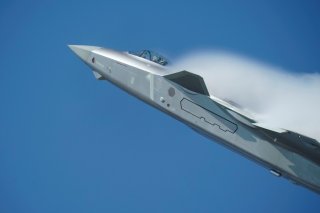China Might Have 250 J-20 Stealth Fighters
China’s Chengdu Aircraft Corporation has now produced between 200 and 250 J-20 Mighty Dragon stealth fighters.
China’s Chengdu Aircraft Corporation has now produced between 200 and 250 J-20 Mighty Dragon stealth fighters.
Given that most of these airframes rolled off the line in the past year or two, this shows a significant increase in production capacity since the J-20 took its maiden flight in 2011.
What Is the J-20?
The J-20 is only the fourth fifth-generation fighter ever designed. It is the first highly advanced aircraft developed entirely in China, making it a landmark achievement for that country’s aerospace and defense industry. Built to counter American F-22s and F-35s, the Mighty Dragon has all the hallmarks of a fifth-gen aircraft, from stealth technologies and supermaneuverability to supercruise and advanced electronics and avionics.
Development began on the J-20 as far back as the 1990s, and in 2008 Chengdu was awarded the final contract to design the fighter for the People’s Liberation Army. Major upgrades came in 2021, when the Russian-designed AL-31FM2 was replaced with the homegrown WS10 engine. That served further proof of the burgeoning might of Chinese aerospace, as the WS10 is remarkably more capable than the Russian import, allowing the J-20 to enter a supercruise regime while unlocking the supermaneuverability granted by thrust vectoring.
Production Increase
Beginning last fall, more production lines have come on for the WS10 and the J-20. Chinese leadership sought to counter the growing number of F-35s in the region. Currently, U.S. allies Japan, South Korea, and Singapore all field the Lightning II, not to mention the U.S. F-35s and F-22s stationed in Japan.
China has been able to significantly increase how many completed units are delivered by using so-called pulsating production lines. This method involves moving every unit in production simultaneously, rather than allowing them to stack at work stations that may take more time. The method is not new — German aircraft manufacturer Junkers used it as early as 1926 — but the sophistication of modern fighter aircraft makes it more challenging.
China Vs. The West
Some experts have pointed out that there are now more operational J-20s than F-22s. This conveniently ignores that F-22 production was halted after only four years due to the lack of a near-peer competitor — only 30% of the initial planned order was produced. Had the J-20 existed at the time of F-22 production, it seems likely the U.S. would have fulfilled the Air Force’s plan for 750 of the airframes.
Furthermore, while many comparisons are made between the J-20 and the F-35A — the U.S. Air Force variant — it is important to remember that the naval services also operate the F-35 in the B and C variant. Added together, the U.S. has more than 500 operational F-35s, more than twice the number of J-20s.
When it comes to F-35 production, Lockheed Martin has planned to deliver 156 airframes per year. Although they missed their target this year, instead hitting only 100-120, when combined with those F-35s already operational, this still creates a nearly insurmountable gap in active fifth-generation fighters, especially when considering the allied nations now beginning to produce the Lightning II.
China’s increased production is impressive—many experts did not expect Chengdu to deliver 100 J-20s until at least 2027. However, the Chinese aerospace industry is still lagging behind the West when it comes to delivering highly advanced fighter aircraft.
Maya Carlin is an analyst with the Center for Security Policy and a former Anna Sobol Levy Fellow at IDC Herzliya in Israel. She has by-lines in many publications, including The National Interest, Jerusalem Post, and Times of Israel.

